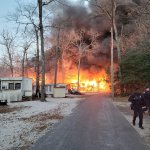Suppose an Association has identified an emergent need for an entirely new low-slope (flat) roof and the existing roof was expected to have a much longer expected service life. For example, often a flat roof will appear fine to visual observation but previously unidentified moisture has infiltrated into the roof system and is often not discovered until leaks are reported into top floor condos.
A thermal imaging survey is performed to identify the extent of the moisture infiltration. A thermal imaging survey identifies temperature variations throughout a roof. Temperature variations point to areas where moisture is present inside the roof. If moisture infiltration is extensive the roof membrane and underlying roof system components may be saturated and compromised. The Association must perform total roof replacement involving removal of the existing roof and installation of a totally new roof system. If the roof problem was not caused by a single casualty incident the Association’s insurance will not cover the cost of the new roof.
In the event of a roof failure, the Association should engage an engineer to determine the cause of the leaks before repairs are performed. The engineer’s role includes educating the Board. There are roof options and the engineer will determine which is most appropriate for the building based on location, weather conditions and even foot traffic. The engineer will prepare plans, specifications, drawings and bid documents. The engineer will identify and solicit qualified contractors. Some roofing systems currently favored by contractors are easier and faster to install and subsequently less expensive when compared to built-up multi-ply roof systems prevalent just a few decades ago. Less expensive roofing systems may be attractive because they cost less but their installation methods may make them less likely to withstand years of severe weather conditions at the shore compared to a traditional built-up multi-ply roof.
Regardless of which roof system is chosen, a new roof should have a warranty from both the roofing contractor that installs the roof and the company that manufactured the roofing materials. The installation contractor must stand behind the quality of his workmanship. The roof substrate must be cleaned, repaired and inspected to ensure that the new roof will adhere properly, otherwise failure to do so may void the manufacturer’s warranty. The material manufacturer must warrant that their products will perform for a defined service life. Roofing material manufacturers typically require that roofing contractors must be “certified” to install their roofing products before providing a warranty to the customer. Roofing warranties are very important since roofing contractors may go out of business.
A roof replacement project usually does not require the roofing contractor to enter any private condominium residences. However in many mid-rise and high-rise buildings the HVAC condenser for each individual residence is located on the roof. Roof replacement requires each of these individual HVAC condensers to be disconnected during roof replacement and reconnected once the new roof has been installed. The roofing contractor may subcontract this work to an HVAC contractor or the Association will contract directly with an HVAC contractor to perform this work. This may invite claims by unit owners for damage to their HVAC units.
The HVAC contractor will need access to each residence at the start and completion of the project. The HVAC contractor will test each HVAC system prior to start of the project, make sure each roof-top condenser is correctly identified with the appropriate residence, disconnect the electric and refrigerant lines to the condenser, capture the refrigerant and record the amount of refrigerant, operating pressures and performance information for each individual HVAC system. Once the new roof has been installed, the HVAC contractor must to ensure the correct condenser is back in place for each unit, reconnect the condenser, recharge with refrigerant and test each HVAC system to ensure it is in the same working condition as prior to the roof project. This step in the roof replacement project is often forgotten and unbudgeted and can be a very expensive part of the project.
Weather dependent exterior projects require special planning. A roofing contractor does not want to be removing large areas of roof membrane in windy and rainy weather. The contractor cannot leave any areas of the building without a roof for extended periods of time. Sections of roof must be removed and replaced during the same day or the roof contractor must take precautions to prevent damage due to unforeseen weather conditions while the roof replacement project is on-going. Likewise, the HVAC
contractor should not be disconnecting heating equipment if temperatures are forecast to drop below freezing.
The engineer’s role during the project is to respond to questions and issues that arise so the contractor can continue to work without interruption. The engineer inspects the existing building structure after the failed roof is removed to ensure the building structure is intact and able to hold the new roof. The engineer conducts periodic field inspections throughout the project to ensure the roofer is installing the new roof according to the plans and specifications, as well as in accordance with the manufacturer’s requirements to ensure the roof is warrantable.
For some projects, a Project Manager may be assigned to oversee the work for the Association. A Project Manager serves as the Association’s representative monitoring and documenting the contractor’s progress and performance during a major project. The Project Manager may coordinate unit access for the HVAC contractor and respond to unit owner questions and concerns. The Project Manager communicates with the engineer and ensures the contractor performs the project in compliance with contract requirements, on schedule and on budget. A manufacturer’s representative should be part of the final inspection to ensure that the product was installed according to the manufacturer’s specifications.
Jim Yost owns Elite Management and Advisory Services, LLC and is Managing Partner of Ocean Property Management Corporation, based in Wildwood NJ. His firms manage over 30 homeowner associations and condominiums in southern New Jersey, including several high rise and mid-rise oceanfront condominium buildings. He can be reached at yostopmc@comcast.net
Karim Kaspar, Esq. is Senior Counsel with Lowenstein Sandler LLP. He serves as general counsel to numerous community and condominium associations throughout New Jersey. He specializes in complex commercial litigation and real estate matters and has been active and instrumental in the firm’s pro-bono activities. He can be reached at kkaspar@lowenstein.com
Cape May County – I’d like to suggest to the Herald that they leverage spout offs draw and replace some of the ads for their paper with a few paid ads that you probably can charge a little extra for. Lots of people…






